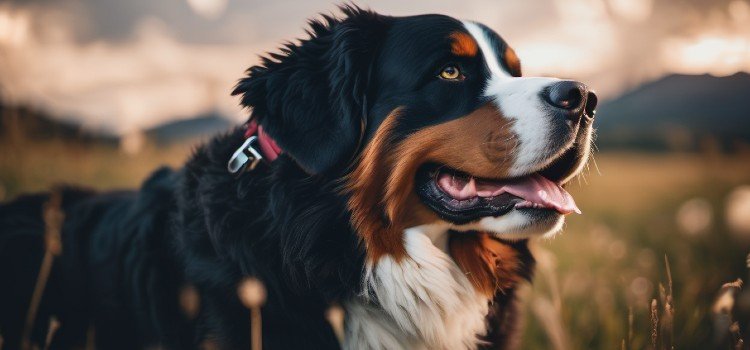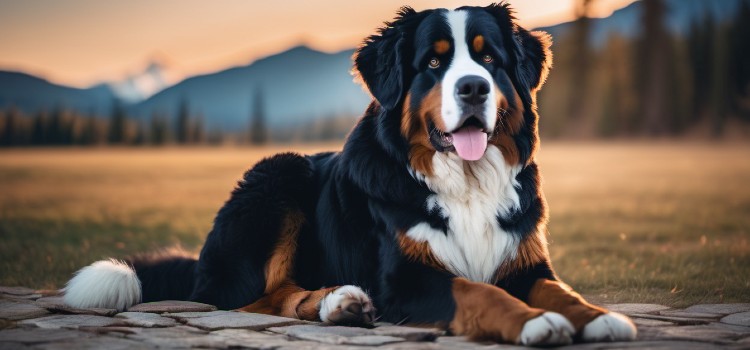As an Amazon Associate committed to the mission of improving the lives of our readers, Live-Clear.com receives a small commission from eligible purchases made through our affiliate links. This revenue enables us to keep producing insightful articles and other material.
A Bernese Mountain Dog can withstand temperatures between 45-85°F (7-29°C) comfortably. Their double coat provides insulation in both hot and cold weather, allowing them to tolerate a range of temperatures.
Bernese Mountain Dogs originated in the Swiss Alps, where they were bred to work in cold climates, making them resilient to cold weather. However, they can also overheat easily in hot weather due to their thick coat, so it’s important to monitor them in high temperatures to prevent heat-related issues.

Understanding their temperature tolerance can help owners ensure the well-being of their Bernese Mountain Dog in different weather conditions.
Understanding A Bernese Mountain Dog’s Coat
Double Coat
A Bernese Mountain Dog has a weather-resistant double coat that consists of a thick, long outer coat and a dense, insulating undercoat. This double-layered coat provides protection against harsh weather conditions, making them well-equipped to withstand low temperatures.
Insulation Properties
The insulation properties of a Bernese Mountain Dog’s coat are remarkable. The undercoat acts as a natural insulator, trapping body heat and providing warmth, while the outer coat repels moisture and wind. This combination enables them to maintain a comfortable body temperature even in extremely cold climates.
Adaptation To Cold Weather
Bernese Mountain Dogs have evolved in the Swiss Alps, where they were originally bred to work in cold temperatures. Their coat not only provides insulation but also aids in regulating their body temperature, allowing them to adapt efficiently to cold weather and harsh winter environments.
Factors Affecting Temperature Tolerance
Factors affecting temperature tolerance play a significant role in determining a Bernese Mountain Dog’s ability to withstand various climate conditions. Understanding these factors is crucial in ensuring the well-being and comfort of these majestic animals.
Genetic Predisposition
The genetic makeup of Bernese Mountain Dogs heavily influences their temperature tolerance. These dogs have a thick, double-layered coat that provides insulation against the cold, making them well-suited for lower temperatures. Their coat also contains oil that serves as a natural water repellent, enabling them to withstand wet and damp environments.
Acclimatization
Bernese Mountain Dogs have the remarkable ability to acclimate to their environment. Through gradual exposure and adaptation, they can tolerate a wide range of temperatures. This adaptability allows them to thrive in both cold and mild climates, making them versatile companions in various geographic locations.
Age And Health Considerations
Age and overall health significantly impact a Bernese Mountain Dog’s ability to tolerate temperature extremes. Puppies and older dogs may have a harder time regulating their body temperature, making them more susceptible to heat or cold stress. Ensuring that they receive proper veterinary care and maintaining their overall well-being is essential in supporting their resilience to temperature variations.

Ideal Temperature Range For Bernese Mountain Dogs
Understanding the ideal temperature range for Bernese Mountain Dogs is crucial for their well-being, as they have a thick double coat that provides insulation in different weather conditions. From cold weather preferences to indoor temperature recommendations and summer heat precautions, it’s essential to pay attention to their comfort and safety.
Cold Weather Preferences
Bernese Mountain Dogs have a natural affinity for colder temperatures due to their thick fur. They feel most comfortable in temperatures ranging between 40°F and 50°F. It’s important to provide shelter and warmth, especially in sub-zero temperatures, as they can withstand extreme cold to a certain extent, but prolonged exposure to harsh conditions can be harmful. While on walks during colder weather, protective gear such as dog sweaters and boots can help keep them warm and comfortable.
Indoor Temperature Recommendations
When indoors, Bernese Mountain Dogs thrive in temperatures between 68°F and 72°F. They should have access to a cozy, warm space during colder seasons to prevent discomfort. Providing them with a soft, insulated bed in a draft-free area of the house is important to ensure their well-being, especially at night when temperatures drop. Keep in mind that they may seek out cooler spots in the home during warmer weather, so providing access to tiled or cool flooring can be beneficial.
Summer Heat Precautions
In the summer, Bernese Mountain Dogs are sensitive to heat and can easily become overheated. Their ideal temperature range during hot weather is between 60°F and 70°F. It’s crucial to provide ample shade and access to cool, fresh water to prevent heat-related issues. Limiting outdoor activities to cooler times of the day, such as early morning or late evening, can help minimize the risk of heat exhaustion. Avoid leaving them in closed vehicles or hot, unshaded areas to prevent heatstroke.
Recognizing Signs Of Discomfort In Bernese Mountain Dogs
Bernese Mountain Dogs can withstand colder temperatures, but they are vulnerable to heat. It’s crucial to monitor them for signs of discomfort in hot weather, such as excessive panting, lethargy, and drooling. Keep them in shaded areas and provide plenty of water to prevent heat-related issues.
Recognizing Signs of Discomfort in Bernese Mountain Dogs The well-being of our beloved four-legged friends is a top priority for every responsible pet owner. When it comes to Bernese Mountain Dogs, it’s crucial to be able to recognize signs of discomfort related to temperature. By understanding behavioral cues, physical symptoms, and temperature-related health risks, you can ensure your Bernese Mountain Dog’s safety and happiness.
Behavioral Cues
Your Bernese Mountain Dog may exhibit several behavioral cues when experiencing discomfort due to temperature. These can include excessive panting, restlessness, and seeking shade or cooler areas. Additionally, they might display signs of lethargy and lack of interest in activities they typically enjoy. Always be attentive to changes in your dog’s behavior, as these can be essential indicators of their comfort levels.
Physical Symptoms
In addition to behavioral cues, it’s important to be mindful of the physical symptoms that may indicate your Bernese Mountain Dog is struggling with the prevailing temperature. Heavy breathing, excessive drooling, and warm skin to the touch are common signs of overheating in dogs. Trembling or shivering can also occur if they are experiencing cold temperatures. Being attuned to these physical manifestations is crucial in safeguarding your dog’s well-being.
Temperature-related Health Risks
Being aware of the potential health risks associated with temperature extremes is imperative when caring for a Bernese Mountain Dog. Heatstroke is a severe concern in warmer climates, while hypothermia can be a risk in colder environments. Both conditions can lead to serious health issues if left unaddressed. Dehydration is another risk to be mindful of, which can be exacerbated by high temperatures. It’s important to keep a vigilant eye on your Bernese Mountain Dog, looking for any signs of discomfort related to temperature. By staying attentive to their behavioral cues and physical symptoms, you can intervene swiftly and effectively, ensuring that your furry companion stays safe and comfortable in any weather conditions.

Acclimatizing Bernese Mountain Dogs To Different Temperatures
Gradual Exposure
When acclimatizing Bernese Mountain Dogs to different temperatures, it is essential to employ a method of gradual exposure. This involves introducing the dog to varying temperature conditions slowly and patiently. Whether it be warm climates or cold environments, gradual exposure allows the dog to adapt to the changes without causing them undue stress or discomfort. A step-by-step approach ensures that the dog’s tolerance levels are built up over time, enabling them to withstand extremes more effectively.
Positive Reinforcement
Positive reinforcement plays a crucial role in aiding Bernese Mountain Dogs to acclimatize to different temperatures. By rewarding the dog for displaying tolerance and composure in varying temperature conditions, they are encouraged to continue exhibiting the desired behaviors. This can be achieved through praise, treats, and affection, reaffirming their ability to adapt and flourish across diverse climates.
Training Methods
Utilizing effective training methods is paramount in guiding Bernese Mountain Dogs to acclimatize to different temperatures. This encompasses implementing reliable and consistent routines, incorporating exposure to a range of temperatures through outdoor activities and simulated environments. By establishing a structured regimen, the dogs can gradually fortify their resilience to heat and cold, ensuring they are equipped to navigate various weather conditions with equanimity.
Ensuring Comfort In Extreme Weather Conditions
The Bernese Mountain Dog is well-suited to tolerate cold weather conditions, thriving in temperatures as low as 45 degrees Fahrenheit. With their thick double coat, they handle extreme cold better than heat, making them an ideal companion for harsh climates.
However, proper care and protection are essential during extremely cold or hot conditions to ensure their comfort and well-being.
Protective Gear
The Bernese Mountain Dog has a thick, double-layered coat that provides natural protection against cold temperatures. However, when exposed to extreme cold, protective gear such as dog boots and insulated jackets can be beneficial in ensuring their comfort.
Shelter Requirements
When the temperature drops, it’s essential to provide shelter that shields your Bernese Mountain Dog from harsh weather conditions. A sturdy and well-insulated dog house or designated indoor space equipped with blankets and a heated bed can offer the necessary warmth and protection.
Temperature Regulations For Outdoor Activities
During outdoor activities, it’s crucial to adhere to temperature regulations to prevent your Bernese Mountain Dog from experiencing discomfort. Avoid exposing them to temperatures below 45°F for extended periods, and use caution when engaging in rigorous activities in high temperatures exceeding 80°F to prevent overheating.
Temperature-related Care Tips For Bernese Mountain Dogs
The Bernese Mountain Dog, with its thick, double-layered coat, is known for its ability to handle cold weather. However, it’s essential to be mindful of temperature-related care to ensure these gentle giants remain healthy and comfortable in varying climates.
Grooming Practices
Regular grooming is crucial for Bernese Mountain Dogs, especially in warmer temperatures. Brushing their coat helps to remove loose fur and prevent matting, which can trap heat and cause discomfort. Additionally, trimming the fur around their paws can prevent ice and snow buildup, while keeping the nails trimmed will aid in maintaining proper traction on slippery surfaces.
Hydration And Nutrition
Proper hydration is essential for Bernese Mountain Dogs, particularly in warmer weather. Access to fresh, clean water should be provided at all times, and owners should monitor their dogs’ intake, especially during outdoor activities. In addition, providing a well-balanced diet helps to support their overall health and ability to regulate body temperature effectively.
Medical Considerations For Temperature Extremes
Monitor for signs of heatstroke, such as excessive panting, drooling, and lethargy, in warmer temperatures. Seek shade and limit exercise during the hottest parts of the day. In contrast, be cautious of hypothermia in cold weather, ensuring they have a warm, sheltered area and protective gear when needed. Regular vet check-ups are crucial for monitoring their overall well-being and providing guidance on temperature-related care.

Conclusion
In the end, Bernese Mountain Dogs can tolerate cold weather, but they have limits. They can handle moderately cold temperatures, but it’s essential to monitor them in extreme conditions. Understanding their tolerance and providing appropriate care will help keep them safe and comfortable in various weather conditions. It is important to remember that every dog is unique and may have different tolerances to cold weather. Some Bernese Mountain Dogs may be more sensitive to the cold than others, so it’s crucial to pay attention to their individual needs. Additionally, providing them with proper shelter, such as a warm and insulated dog house, can further protect them from extreme weather conditions.
Frequently Asked Questions On What Temperature Can A Bernese Mountain Dog Withstand
Yes, Bernese mountain dogs are well-suited for cold weather due to their thick, double coat. Their fur provides insulation, keeping them warm in chilly conditions. It’s important to monitor them in extreme cold and provide shelter when necessary.
Yes, Bernese mountain dogs may need snow boots in extreme cold or icy conditions to protect their paws.
Dogs can be outside in temperatures as low as 45°F (7°C) for short periods. However, when the temperature drops below this, it could be too cold for your dog. It’s important to monitor their behavior and provide adequate shelter in colder weather.
Dogs can tolerate temperatures between 45°F to 85°F, depending on breed and health. However, extreme heat or cold can be dangerous. Watch for signs of distress and adjust accordingly. Keep them hydrated in hot weather and provide warmth in cold temperatures.
The ideal temperature for a Bernese Mountain Dog is between 50-65°F.
Bernese Mountain Dogs are adapted to cold weather but have limits. They can handle moderate temperatures, but extreme conditions require monitoring. Understanding their tolerance and providing appropriate care is crucial for their safety. Each dog is unique and may have different tolerances, so it’s essential to pay attention to their individual needs. Providing proper shelter, such as a warm and insulated dog house, can further protect them from extreme weather conditions.
Amazon and the Amazon logo are trademarks of Amazon.com, Inc, or its affiliates.



